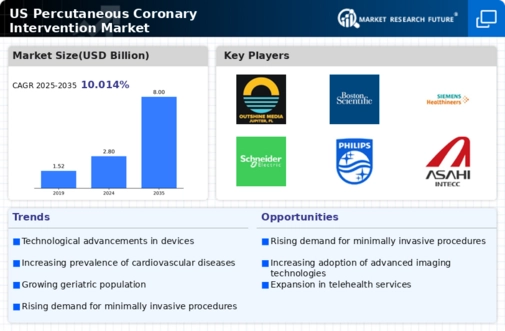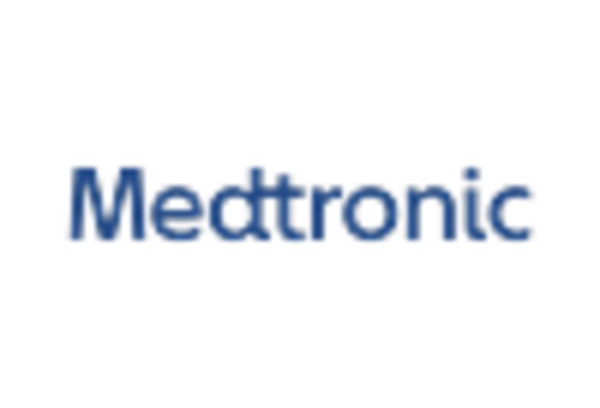Increasing Aging Population
The Aging Population in the US is a critical driver for the percutaneous coronary-intervention market. As individuals age, the prevalence of cardiovascular diseases tends to rise, leading to a higher demand for interventional procedures. According to recent statistics, approximately 80% of individuals aged 65 and older have at least one chronic condition, with cardiovascular diseases being predominant. This demographic shift is expected to continue, with projections indicating that by 2030, around 20% of the US population will be 65 years or older. Consequently, healthcare providers are likely to increase their focus on percutaneous coronary interventions to address the growing needs of this population, thereby propelling market growth.
Rising Healthcare Expenditure
The increasing healthcare expenditure in the US is another significant driver for the percutaneous coronary-intervention market. With healthcare spending projected to reach $6 trillion by 2027, there is a growing investment in advanced medical technologies and procedures. This financial commitment allows for the adoption of innovative interventional techniques and devices, which are essential for effective treatment of coronary artery diseases. Moreover, as insurance coverage expands and more patients gain access to healthcare services, the demand for percutaneous coronary interventions is likely to rise. This trend indicates a robust market environment, fostering growth opportunities for stakeholders in the percutaneous coronary-intervention market.
Growing Awareness and Education
Increasing awareness and education regarding cardiovascular health are vital drivers for the percutaneous coronary-intervention market. Public health campaigns and educational initiatives have led to a greater understanding of heart disease risk factors and the importance of early intervention. As individuals become more informed about their health, they are more likely to seek medical advice and treatment options, including percutaneous coronary interventions. This heightened awareness is reflected in the rising number of patients undergoing these procedures, which has seen an increase of approximately 10% annually over the past few years. Consequently, this trend is expected to continue, further propelling the market.
Advancements in Medical Technology
Technological innovations play a pivotal role in shaping the percutaneous coronary-intervention market. The introduction of advanced imaging techniques, such as intravascular ultrasound and optical coherence tomography, enhances procedural accuracy and patient outcomes. Furthermore, the development of new stent designs and drug-eluting technologies has significantly improved the efficacy of interventions. For instance, the market for drug-eluting stents is projected to reach approximately $5 billion by 2026, reflecting a compound annual growth rate (CAGR) of around 7%. These advancements not only facilitate better treatment options but also attract more patients to seek percutaneous coronary interventions, thereby driving market expansion.
Enhanced Patient Outcomes and Safety
The focus on improving patient outcomes and safety is a crucial driver for the percutaneous coronary-intervention market. With ongoing research and clinical trials, the efficacy and safety profiles of various interventional techniques are continuously being evaluated and improved. The introduction of minimally invasive procedures has led to reduced recovery times and lower complication rates, making these interventions more appealing to both patients and healthcare providers. As a result, the number of procedures performed is likely to increase, contributing to market growth. Furthermore, positive patient outcomes can enhance the reputation of healthcare facilities, encouraging more patients to opt for percutaneous coronary interventions.

















Leave a Comment